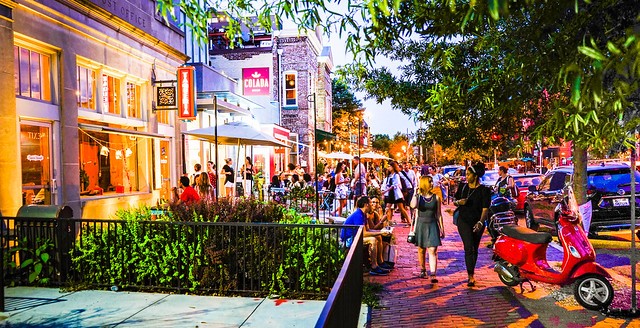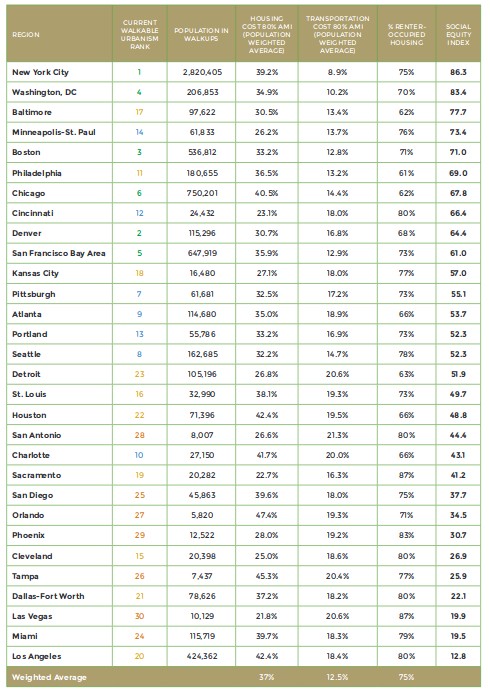The Washington region remains one of the most walkable in the country

Image by Ted Eytan licensed under Creative Commons.
City and suburb, the Washington region remains one of the most walkable in the nation, although it may be losing ground against other urban areas. That’s one of the findings from a new report, “Foot Traffic Ahead: Ranking Walkable Urbanism in America’s largest Metros 2019.”
Surprisingly, our region scores highly (number two in the nation) in “social equity” in housing, a finding that is “counter-intuitive” according to the study’s authors, the Center for Real Estate and Urban Analysis at the George Washington University School of Business, in partnership with Locus Smart Growth America and others.
The report also found that with an eighth of its commercial real estate in walkable suburban areas, the Washington region has more investment in that category than any other city in the country. And across the country, buildings are worth 75% more when they’re in walkable places.
The report is the third in a series; the previous editions were published in 2016 and 2014. It measures economic, social, and demographic trends in 761 “walkable urban places” (called “WalkUPs” in the report) in the 30 largest metro areas in the US. The rankings reflect the square footage occupied by the office, retail, and multi-family residential buildings in WalkUP areas.
Walkable Urbanism Scorechart from the Foot Traffic Study by The Center for Real Estate and Urban Analysis used with permission.
The Washington region falls in the rankings. Is it significant?
Washington is number four in this year’s rankings—behind New York City, Denver, and Boston, in that order. This is a decline from our area’s second place in the 2016 report, which in turn was a decline from first place in the 2014 edition. Is the region’s walkability actually declining relative to other US cities?
“While the top ranked metros are all very close together in their level of walkable urbanism, their relative ranks are a bit hair-splitting,” said Tracy Hadden Loh, one of the report’s co-authors. (Loh is also a contributor to Greater Greater Washington and a member of its advocacy committee.) “The data show that the DC region is adding inventory in both WalkUPs and the drivable suburbs, while Boston is basically only growing in walkable urban places—demonstrating that ending sprawl is possible, and inching Boston ahead in the rankings.”
In addition, this year’s version of the report had some changes in methodology. For example, data from the city of Boulder, Colorado was included in Denver’s calculations for the first time—a change that was partially responsible for its climb in the ranks from ninth place in the 2016 walkability report to second place in 2019.
Image by The Center for Real Estate and Urban Analysis used with permission.
Washington ranks HIGH in social equity? Really?
Many local residents might be surprised to hear that WalkUPs in our area rank number two in social equity, just behind New York City, according to the report. The social equity metric focuses on households making 80% of area medium income (AMI)—equivalent to about $94,000.
Even the report’s authors admit that these findings “appear counter-intuitive,” since inhabitants of WalkUP areas in our region and elsewhere usually pay a considerable premium to live in them. In the Washington region, according to the report, a household making 80% of the AMI spends 34.9% of their income on housing, well above the yardstick of 30% recommended by the US Department of Housing and Urban Development.
However, residents in Washington region WalkUPs spend only only 10.2% of their income on transportation, substantially lower than the national average of 16.9%, due to the availability of “more diverse and less expensive transportation options, such as transit, biking and walking.” This is may be why Washington ranked so high in the social equity rankings.
Washington is the top region for walkable suburbs
The Washington region is leading the nation in investment in walkable “suburbs,” which it defines as areas outside the center city. It’s the #1 metropolitan area in the US for the percentage of its commercial real estate square footage in non-center city walkable places- 13%. Boston comes in a close second, at 12%, and Atlanta in a distant third, with 5%.
“The Boston and Washington, DC metro areas serve as models for future walkable urban development because the regions are capitalizing on opportunities to urbanize suburban places, as well as continuing to develop walkable places within their central cities,” the report states. It specifically attributes much of this growth to Arlington, Reston, Bethesda, Silver Spring, and Tysons.
Largely because of this suburban trend, and despite DC’s surprisingly low rate of growth in the walkable urban market share (ranked 22nd out of 30), the report ranked the DC Metro in 4th place for “Future Growth Momentum.”
Buildings in walkable places are worth more
The report examined the “rent premium” of buildings in WalkUPs. It found that, across the country, tenants were willing to pay 75% more to be in a walkable area. In Washington specifically, that figure was close to the national average (67%).
However, unlike most other major metropolitan areas, that figure hasn’t increased over the past eight years. According to the report, this may indicate that Washington “may have peaked out in walkable urban rental rate growth for this cycle,” and that the metro area is successfully addressing the market demand for walkable places.
Caveats and future directions
Like any study addressing such a complex topic, the study acknowledges a few meaningful omissions that may be partially responsible for the conclusions we’ve seen.
First, the report has an eagle-eye focus on commercial real estate. WalkUPs only measure multifamily apartment buildings and retail and office space, and don’t include walkable urban neighborhoods—like Columbia Heights, Capitol Hill, or Arlington’s Lyon Village—that are predominantly residential. The DC area has a significant stock of these neighborhoods, but they’re not being counted. If these areas had been included, DC’s walkability score would likely have been much higher.
Second, the report defines “suburbs” as all areas outside of the central jurisdiction. That’s a big part of the reason that DC and Boston have such a high percentage of suburban WalkUPs: their borders are smaller than in many other center cities.
